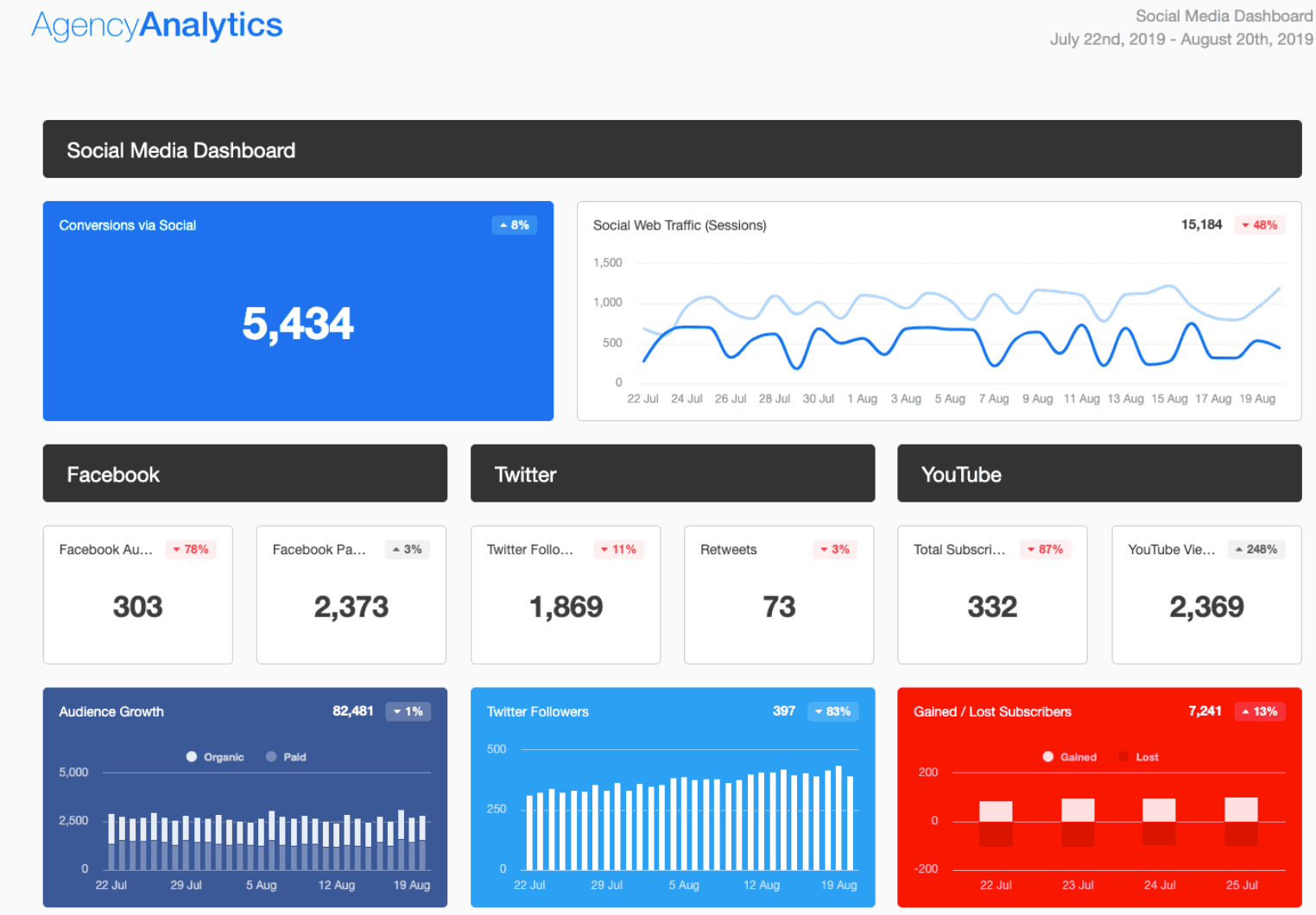Table of Contents
Table of Contents
- First Things First: What's the Difference Between Social Commerce and eCommerce?
- Why is Social Commerce Important and What are the Social Commerce Trends?
- Social Commerce Examples: 3 Brands with a Successful Social Commerce Strategy to Inspire You
- How to Use Social Shopping to Scale Your Client's eCommerce Store
- Use Social Media Reporting to Your Agency (and Client’s) Advantage
- Summary: Social Media Reporting is Key to a Successful Social Commerce Strategy
7,000+ agencies have ditched manual reports. You can too.
Free 14-Day TrialQUICK SUMMARY:
Social commerce is rapidly integrating into the eCommerce landscape, transforming followers into potential buyers through in-app purchases. This article explores how marketing agencies can leverage social commerce to generate leads, empower brands, and drive sales. Discover effective strategies and reporting tools to keep up with fast-changing social media trends and ensure client success.
Social media marketing has changed a lot since pre-pandemic times. Take the social commerce market, for instance. It is quickly gobbling up a large slice of the eCommerce market. Followers of your clients’ brands are all potential buyers: as they scroll through their social media feeds, browse a Facebook shop, or attend live shopping events, they are prompted to make in-app purchases at the touch of a few buttons.
With endless scrolling, social commerce demands a ton of new content daily. But social media also generates leads, empowers brands, and entices customers to make purchases based on social proof. Social commerce strategies can cater to both existing and potential customers by enhancing user experience, thereby driving retail social commerce sales and customer loyalty. So how can your agency set up its clients’ businesses for success on social media channels?
What social media reporting tools can accurately measure the fast changes in the market so that your clients keep up with social media trends that change faster than any e-commerce platform or brick-and-mortar storefront ever could?
Let’s dig deeper.
First Things First: What's the Difference Between Social Commerce and eCommerce?
While eCommerce entails the overall process of buying and selling goods online, social commerce involves selling products and services to consumers directly and solely through social media platforms like TikTok, Instagram, Twitter, Pinterest, Snapchat and Facebook. An online store is a fundamental aspect of traditional eCommerce, distinguishing it from social commerce, where transactions occur directly on social media platforms. 93% of US executives say their businesses are moving eCommerce efforts to social media. As a marketing agency, you have to keep up with changes in online shopping behaviour and evolve your social commerce strategy to match new industry standards.
On the plus side, unlike typical social media advertising and marketing, social commerce provides a seamless experience for digital shoppers who are perusing their favourite influencers’ feeds.
Now, almost everything you see on social media is shoppable. Instagram shopping allows your clients’ customers to ‘like’ new products as soon as they appear. Not only that, but they expect their door to ring with their new package between 3-5 business days if that ‘like’ turns into a buy.
The Instagram heart icon has made way for the shop tab for good, it seems. 130 million Instagram users tap on shopping posts every month.
And with social commerce features like the Livestream, your clients can boost product discovery, strengthen brand awareness and connect with their customers all within the same app. Community is strengthened, and growth opportunities balloon with sharing happening across social networks.
Why is Social Commerce Important and What are the Social Commerce Trends?
US retail social commerce sales hit $46.39 billion in 2020 and are expected to grow to $79.64 billion by 2025. Social media shopping allows for more personalized interactions between customers and brands. Retail companies are even using conversational shopping assistant chatbots on Facebook Messenger to help increase their conversion rates by 5 times.
When other customers make purchases and post them on social media, it increases the likelihood that the next person will buy what they see. Today, over 99.9% of consumers say they read reviews “at least sometimes” when online shopping. A cornerstone of digital marketing is the customer journey. What better trust-building and brand visibility boosting tool is there than social proof? What’s better, it is intrinsically a part of social commerce.
User generated content enhances brand credibility and significantly influences purchasing decisions by providing social proof.
While millennials do their shopping online more than ever, Gen Z has taken it to another level and makes purchases entirely without leaving a social media platform. Company executives overwhelmingly agree that social shopping boosts their marketing-driven revenue. 8 in 10 executives expect to be selling their services and products through socials within the next three years.
With social media users projected to grow to almost 4.41 billion by 2025, social commerce is expected to continue growing. According to the Pew Research Center, 72% of American adults use at least one social media platform, with the figure rising to 84% among younger adults.
Social Commerce Examples: 3 Brands with a Successful Social Commerce Strategy to Inspire You
Let’s take a look at three brands that are using social commerce effectively and what we like about their social commerce strategies:
Patagonia
Social platforms like Pinterest are ideal product navigation tools for their target market. Patagonia’s Product Pinboards mimic its eCommerce website navigation, creating a familiar browsing experience for new and returning customers who click through the brand’s main site. Customers effortlessly browse through the different products and finalize the checkout process without leaving Pinterest.
The Tiny Tassel
The Tiny Tassel is a leading handmade jewelry retailer using social media sites like Facebook and social commerce tools to build informative product pages. Each product has a detailed description, shipping information, and customization options. Its lead and post listings create value that builds trust with potential buyers, motivating them to purchase within the platform.
DSW
Shoe shopping was never easy. Showing what your product looks like in real-life scenarios is a significant challenge most eCommerce retailers face. DSW solved this problem by creatively using Instagram’s Reel feature to show how their shoes would fit IRL. They launched a hashtag campaign #MyDSW prompting their customers to show how they wear their DSW fashions, apparently resulting in a 2x conversion lift. This is part of their successful social commerce strategy.
How to Use Social Shopping to Scale Your Client's eCommerce Store
So how can you incorporate social commerce into your client’s marketing stack? Here are a few tips to get your eCommerce clients started in the right direction:
Choose the right social media platform where your clients’ target audience spends the most time
Optimize content for mobile
Use social proof like encouraging followers to share photos, and discuss the influencer marketing budget with your clients
Read More: Here are 8 Key Metrics to Track Influencer Marketing Performance
Streamline the Purchase Process - Products should be clickable with clear product pricing
Track social commerce metrics closely and use a customizable social media reporting tool that brings all your clients’ social metrics together in one place
Read more: How to Build a Social Media Dashboard for Clients
This brings us to the next point:
Use Social Media Reporting to Your Agency (and Client’s) Advantage
As important as it is for your agency to measure the success of its social commerce strategy using social commerce platforms, it is also important for you to communicate it clearly with your clients who are interested in the bottom line.
From conversion rates that increase online sales to engagement, here are 12 Key Metrics to Track the ROI of Social Media Marketing. With a dedicated social media dashboard, automate your client’s reporting process and automatically track each of these critical social media KPIs from one unified dashboard:

Summary: Social Media Reporting is Key to a Successful Social Commerce Strategy
Marketing agencies need to differentiate social commerce metrics from their clients’ eCommerce metrics to make informed decisions to drive their marketing strategies going forward. This requires a constant finger on the market pulse, and the ability to measure campaigns performance automatically without too much back-and-forth.
Constantly analyzing all your clients’ key social media metrics is challenging, especially when you have to collect data manually from various platforms. AgencyAnalytics is an all-in-one social media reporting for agencies that automates the entire data collection and reporting process. See our social media report template can wow your clients.
It collects data from various integrations and reports these metrics to your clients within minutes, saving you time and scaling your marketing agency. Want to learn how to scale your marketing agency with automated client reporting? Start your free trial today to track your social commerce and eCommerce metrics.

Written by
Melody Sinclair-Brooks brings nearly a decade of experience in marketing in the tech industry. Specializing in B2B messaging for startups and SaaS, she crafts campaigns that cut through the noise, leveraging customer insights and multichannel strategies for tangible growth.
Read more posts by Melody Sinclair-BrooksSee how 7,000+ marketing agencies help clients win
Free 14-day trial. No credit card required.






